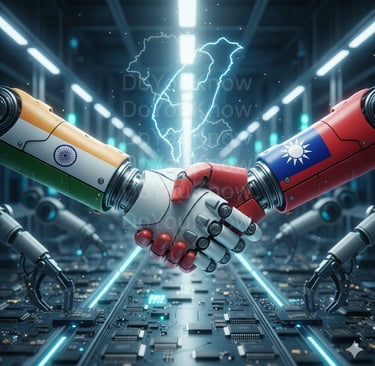Do You Know How India-Taiwan Tech Partnerships Could Reshape the Local Electronics Industry
India-Taiwan tech ties are reshaping electronics manufacturing. From semiconductors to supply chains, explore how this partnership could change India’s future.
TECH & SCIENCEWORLD & POLITICS
Do You Know Team
9/27/20255 min read


When one thinks of the global electronics industry, two names often come to mind: Taiwan, the world’s leader in semiconductor production, and India, a rapidly growing market with immense potential for electronics manufacturing. While India has historically been dependent on imports for critical electronic components, recent developments indicate that the tides are changing.
At the heart of this transformation lies the India-Taiwan tech partnership. It’s not just about trade or investment — it’s about strategic collaboration that could fundamentally reshape the future of India’s electronics sector. With Taiwan’s technological expertise and India’s growing demand, workforce, and policy push under “Make in India” and “Digital India”, the synergy between the two nations promises to be a game-changer.
The partnership goes beyond semiconductors — it spans across display technologies, 5G infrastructure, green energy, electric mobility, and even artificial intelligence applications in hardware design. If nurtured effectively, this collaboration could not only strengthen India’s position as a global manufacturing hub but also help it achieve self-reliance in critical technologies, reducing dependency on imports from China.
So how exactly are India and Taiwan collaborating? Why is this partnership so crucial now? And what could it mean for India’s local electronics ecosystem in the years ahead?
Let’s explore the story in detail.
The Background: India’s Electronics Industry at a Crossroads
India’s electronics sector has grown rapidly in recent years, driven by rising consumer demand for smartphones, laptops, appliances, and connected devices. Yet, despite this growth, India has remained overly dependent on imports for key components such as semiconductors, printed circuit boards (PCBs), display panels, and sensors.
Some critical challenges faced by India include:
High import dependency: Over 65% of India’s electronics components are imported, with China dominating supply chains.
Lack of domestic semiconductor fabrication units: While India has strong design talent, it does not yet have large-scale fabs to produce advanced chips.
Fragmented supply chains: Domestic players rely heavily on imports for raw materials and sub-components, raising costs and time delays.
Global competition: Countries like Vietnam and Malaysia have already established themselves as preferred hubs for global electronics manufacturing.
The government, recognizing these vulnerabilities, has launched a series of initiatives such as the Production Linked Incentive (PLI) scheme for electronics, the Semicon India Program, and Electronics Manufacturing Clusters (EMC 2.0) to make India more competitive. However, policies alone are not enough — India needs strategic partners with proven expertise.
This is where Taiwan comes in.
Why Taiwan Matters: The Global Tech Powerhouse
Taiwan is often called the Silicon Shield of the world. It produces over 60% of the world’s semiconductors and more than 90% of the world’s most advanced chips through companies like TSMC (Taiwan Semiconductor Manufacturing Company).
Beyond semiconductors, Taiwan has:
Advanced expertise in electronics assembly, display manufacturing, sensors, and chip packaging.
Robust ecosystems for startups, R&D, and industry-academia collaboration.
A history of being the go-to partner for global electronics giants such as Apple, Qualcomm, and Nvidia.
For India, which is seeking to strengthen its domestic electronics value chain, Taiwan represents an ideal partner — technologically advanced, politically aligned (in balancing China’s dominance), and eager to diversify its manufacturing base.
India-Taiwan Tech Diplomacy: A Quiet But Strong Partnership
Despite not having official diplomatic ties (owing to the One-China policy), India and Taiwan have steadily built strong economic and technology partnerships.
Some milestones include:
India-Taiwan Economic Cooperation Agreement (ITECA) signed in 2018 to boost bilateral trade and investments.
Taiwan-India Industrial Collaboration Summits held regularly to connect businesses.
Establishment of Taiwan-India Entrepreneurship Development Centers to encourage startups.
Growing Taiwanese investments in electronics, ICT, and green energy projects in India.
In 2023 and 2024, discussions intensified around semiconductor collaborations, with Taiwan considering investments in India’s semiconductor ecosystem under the Semicon India Program.
The Semiconductor Story: Heart of the Partnership
The most crucial area of collaboration is undoubtedly semiconductors.
Why? Because semiconductors are the brain of modern electronics — powering everything from smartphones to cars, defense systems, AI applications, and 5G networks.
India has:
A large talent pool in chip design (many engineers working in Intel, Qualcomm, Broadcom are Indian).
Strong demand for chips, with its electronics market projected to reach $400 billion by 2030.
But India lacks:
Advanced semiconductor fabs.
Expertise in high-yield chip production.
Taiwan, on the other hand, has everything India lacks. By bringing TSMC, UMC, and other Taiwanese players into India, the two nations can create a win-win model: India provides the talent and demand, while Taiwan provides manufacturing know-how and supply chain integration.
This could drastically reduce India’s import bill and strengthen local supply chains.
Beyond Chips: Expanding the Partnership
While semiconductors take the spotlight, India-Taiwan partnerships extend to other critical areas:
Display manufacturing: Taiwan is working with Indian firms to set up TFT-LCD and AMOLED display units in India, reducing imports from South Korea and China.
5G and telecom equipment: Taiwanese companies are exploring partnerships with Indian telecoms for 5G rollout and future 6G research.
Electric mobility: Battery technology and EV components are another focus area, where Taiwan’s R&D aligns with India’s EV adoption goals.
AI and IoT hardware: Joint projects are emerging in smart sensors, robotics, and IoT devices for Industry 4.0 applications.
Green energy and sustainability: Taiwan’s solar cell expertise can support India’s renewable energy transition.
Opportunities for India’s Local Electronics Industry
The ripple effects of stronger India-Taiwan ties on the local electronics industry could be enormous:
Boost to domestic manufacturing: By localizing production of chips, displays, and PCBs, India can cut import dependency.
Rise of MSMEs and startups: Smaller firms can plug into global supply chains by collaborating with Taiwanese players.
Skill development: Taiwan’s training models can help upskill Indian engineers for next-gen technologies.
Job creation: High-tech manufacturing units can create thousands of high-paying jobs in India.
Exports growth: India can not only meet local demand but also export to global markets as part of the Taiwan-led ecosystem.
Challenges to Overcome
Of course, the journey won’t be easy. Some challenges include:
Geopolitical risks: China may see India-Taiwan ties as provocative.
Infrastructure bottlenecks: India still faces power, logistics, and land availability issues.
High capital intensity: Semiconductor fabs require billions of dollars in investment.
Skill gaps: India must train a workforce ready for ultra-precision manufacturing.
Yet, with proper planning, these hurdles can be overcome.
Future Outlook: A Strategic Tech Alliance
If nurtured, India-Taiwan tech partnerships could do three things:
Make India a self-reliant electronics hub, reducing its $70+ billion electronics import bill.
Position India as a key player in global semiconductor and electronics supply chains.
Strengthen India’s geopolitical positioning by creating alternative supply chains outside of China.
This is not just about economics — it’s about technology sovereignty, national security, and long-term global competitiveness.
FAQs
Q1: Why is Taiwan important for India’s electronics industry?
Taiwan is the world leader in semiconductors and electronics manufacturing. Partnering with Taiwan helps India reduce import dependency and build local capacity.
Q2: How will India benefit from these partnerships?
India will gain advanced technologies, manufacturing know-how, skilled jobs, and stronger global positioning in electronics supply chains.
Q3: Will this affect India-China relations?
Yes, closer India-Taiwan ties may cause friction with China, but India is pursuing it as part of its strategy to diversify supply chains.
Q4: What role do Indian startups and MSMEs play?
They can collaborate with Taiwanese firms to integrate into global supply chains, especially in IoT, robotics, and component manufacturing.
Q5: Which sectors are most promising?
Semiconductors, display manufacturing, EV components, 5G equipment, and green energy.
Conclusion
The India-Taiwan partnership in technology is one of the most promising yet understated developments in Asia’s economic landscape. By combining Taiwan’s manufacturing excellence with India’s talent and demand, the two nations can create a powerful alliance that reshapes the future of electronics.
For India, this means moving from being a consumer-driven electronics market to becoming a global manufacturing and innovation hub. For Taiwan, it means diversifying its base and securing long-term partners. For the world, it means more resilient supply chains.
In short, India-Taiwan tech collaborations have the power to reshape not just India’s local electronics industry but the very architecture of global technology flows.
#IndiaTaiwan #ElectronicsManufacturing #SemiconductorIndia #TechPartnerships #DoYouKnow #MakeInIndia #DigitalIndia #SupplyChainIndia
Knowledge
Empowering minds with reliable educational content daily.
Newsletter Signup
© 2025 DoYouKnow. All rights reserved.
Stay Ahead of the Trends – Join Our Newsletter
